Samuel Whitaker is a professional chef who has a passion for canning. He appreciates the art of preserving food and enjoys teaching others how to do it. He has written numerous articles on the subject.
Understanding the correct placement of cans during the canning process is crucial to achieving optimal results. This canning process guide will explore the two primary orientations for canning jars: upright and on their side. Both methods have their unique benefits and drawbacks, and the choice between them often depends on the type of food you're canning, the canning machine you're using, and your personal preference.
Have you ever wondered why canning lids usage differs from one method to another? Or why some steam canning techniques recommend one orientation over the other? The answers to these questions lie in the science of canning. When it comes to home canning, following USDA canning guidelines is essential for safety and quality. Whether you're a beginner or a seasoned canner, understanding the principles behind canning jar orientation can make all the difference in your canning endeavors.
So, should cans be placed upright or on their side during the canning process? Let's delve into the specifics of each method to find out. For more information on safe canning practices, check out our article on common canning mistakes and how to avoid them.
Standing Tall: The Upright Method in Canning 🥫
When it comes to the upright method, it's the most commonly used approach in the canning process. The canning jars are placed upright in the canning machine or pressure canner, with the canning lids securely fastened. This orientation allows for optimal heat distribution, ensuring that the food is properly preserved. Furthermore, it reduces the risk of food particles interfering with the sealing process, which could compromise the safety of your canned goods.
However, the upright method does have its drawbacks. For instance, it requires more headspace, meaning you may not be able to fit as many jars in your canner. Plus, if the jars are not filled correctly, or if they contain a lot of liquid, there's a risk of siphoning, where the liquid boils over and interferes with the seal.
Despite these potential issues, the upright method remains a popular choice, especially for beginners. It's easy to follow, and with careful attention to filling and headspace, you can achieve excellent results. Remember, the key to successful canning is always following the USDA canning guidelines and using the right equipment, including high-quality canning lids and jars. If you're new to canning, you might find our guide on how to start canning at home useful.

Lying Low: Exploring the Side Method in Canning 🔄
Turning our attention to the side method in canning, it's essential to note that this technique is not as commonly used as the upright method. However, it does have its merits. For instance, when using a steam canning technique, placing your canning jars on their side can allow for better heat distribution, ensuring that your food is thoroughly and evenly processed.
Yet, there are some potential drawbacks to this method. The orientation of the canning lids during the process is crucial. If improperly placed, the lids might not seal correctly, which can lead to spoilage. Furthermore, the USDA canning guidelines do not explicitly recommend this method, which can make some home canners hesitant to try it.
So, is the side method for you? It might be, especially if you're using steam canning techniques. But remember, proper canning lids usage is key, and always refer to a reliable canning guide or the USDA pressure canning guide for best practices. Like many aspects of canning, the choice between the upright and side method often comes down to personal preference and the specific needs of what you're canning.

After considering all the factors, such as the type of food being canned, the canning process used, and your personal preference, I recommend using the upright method for most home canning projects. This method aligns with the USDA canning guidelines and has been proven to be effective and safe over time. It ensures a proper seal, which is crucial in preserving the quality and safety of your canned goods.
However, the side method might be more suitable for specific situations, like when using a steam canning technique or when canning certain types of food. It's all about finding what works best for you and your canning needs.
Remember, the orientation of your canning jars during the process can significantly impact the final product. So, take your time to understand the pros and cons of each method. And don't forget, whether you choose the upright or side method, always inspect your canning lids for a good seal after processing.
Ready to start your canning journey? Check out our home canning guide or the USDA pressure canning guide for more detailed information. Happy canning!




![[6 Pack] 16 oz. Regular-Mouth Glass Mason Jars with Metal Airtight Lids and Bands for 1 Pint Canning, Preserving, & Meal Prep](https://m.media-amazon.com/images/I/71mCH-Kt6QL._AC_SX444_SY639_QL65_.jpg)
![SEWANTA Wide Mouth Mason Jars 16 oz [5 Pack] With mason jar lids and Bands, mason jars 16 oz - For Canning, Fermenting, Pickling - Jar Décor - Microwave/Freeze/Dishwasher Safe](https://m.media-amazon.com/images/I/91pcfxG3dtL._AC_SX444_SY639_QL65_.jpg)





![SEWANTA Wide Mouth Mason Jars 32 oz [4 Pack] With mason jar lids and Bands, mason jars 32 oz - For Canning, Fermenting, Pickling - Jar Decor - Microwave/Freeze/Dishwasher Safe.](https://m.media-amazon.com/images/I/81O6XmQwSqL._AC_SX444_SY639_QL65_.jpg)


















